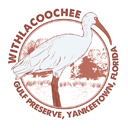 If you have walked the trails at the Preserve you may not have given lichens a second thought. Or perhaps mistaken them for another organism, like a moss. If this is the case, then you have missed out on wonders of the natural world.
If you have walked the trails at the Preserve you may not have given lichens a second thought. Or perhaps mistaken them for another organism, like a moss. If this is the case, then you have missed out on wonders of the natural world.
A lichen is not a single organism, but rather a mutualistic community of at least two different species: a fungus and a photosynthetic alga or cyanobacterium. Lichens can be divided into three principal body categories.
- Fruticose lichens are highly branched and can grow like shrubs.
- Crustose (crustlike) lichens adhere tightly to their substrate.
- Foliose (leafy) lichens are loosely attached and grow parallel to their substrate.

On a January 2020 Citrus Native Plant Society field trip lichenologists Ann DeBolt and Roger Rosentreter pointed out that all three lichen categories can be found on many substrates at the Preserve: on tree bark, on open soil, and on bare rock.
To learn more about lichens:
- Florida Lichen Field Guide (by Ann DeBolt, Roger Rosentreter, et al.)
- Lichen photographer and biologist Tim Wheeler (video)




 The WGP management plan calls for the periodic survey of the Preserve for invasive plants. Yankeetown was fortunate to have Marc Frank (Extension Botanist, UF/IFAS), Lucas Majure (Curator at UF Herbarium), and several of their colleague and students conduct a survey on October 5, 2018.
The WGP management plan calls for the periodic survey of the Preserve for invasive plants. Yankeetown was fortunate to have Marc Frank (Extension Botanist, UF/IFAS), Lucas Majure (Curator at UF Herbarium), and several of their colleague and students conduct a survey on October 5, 2018. 

